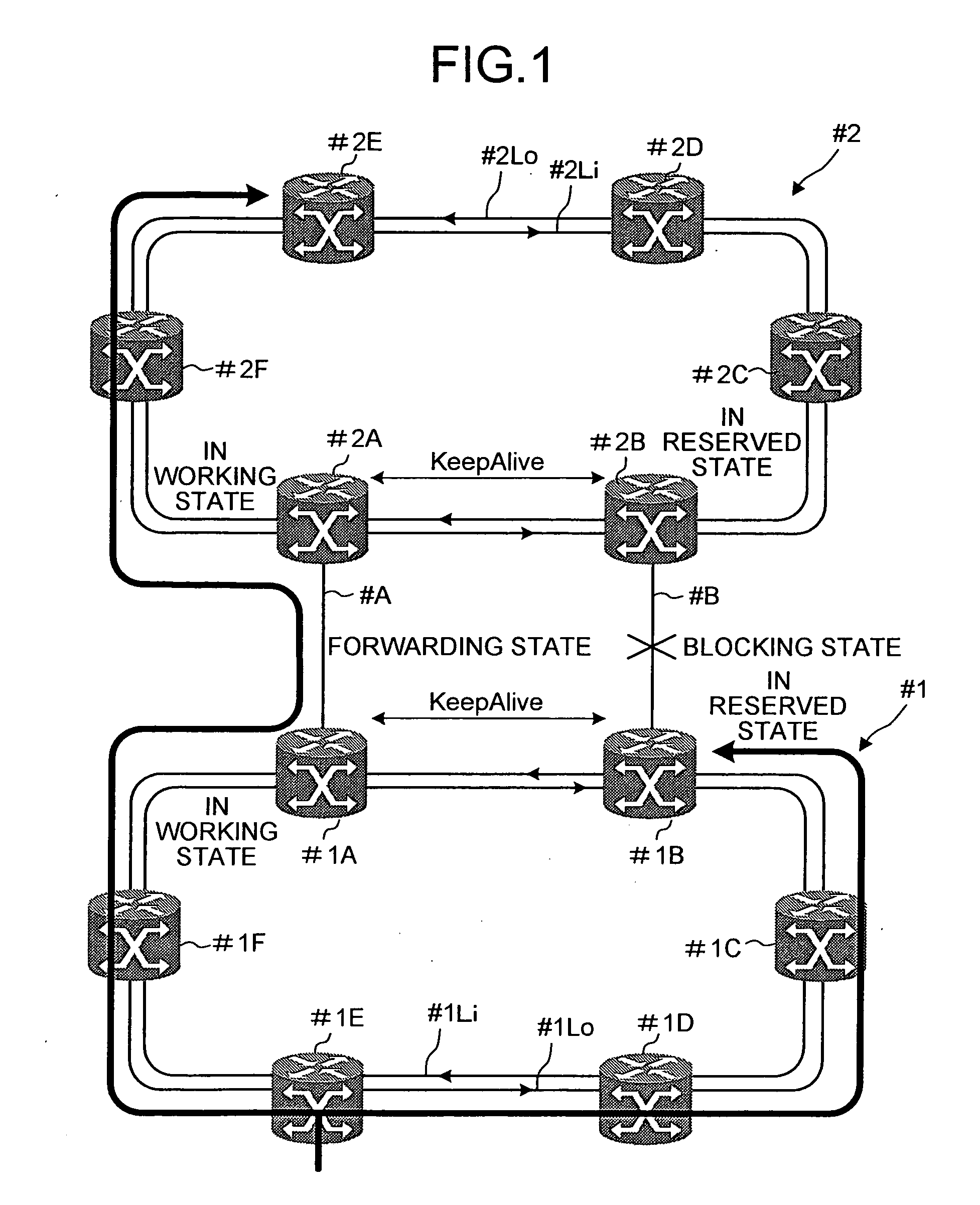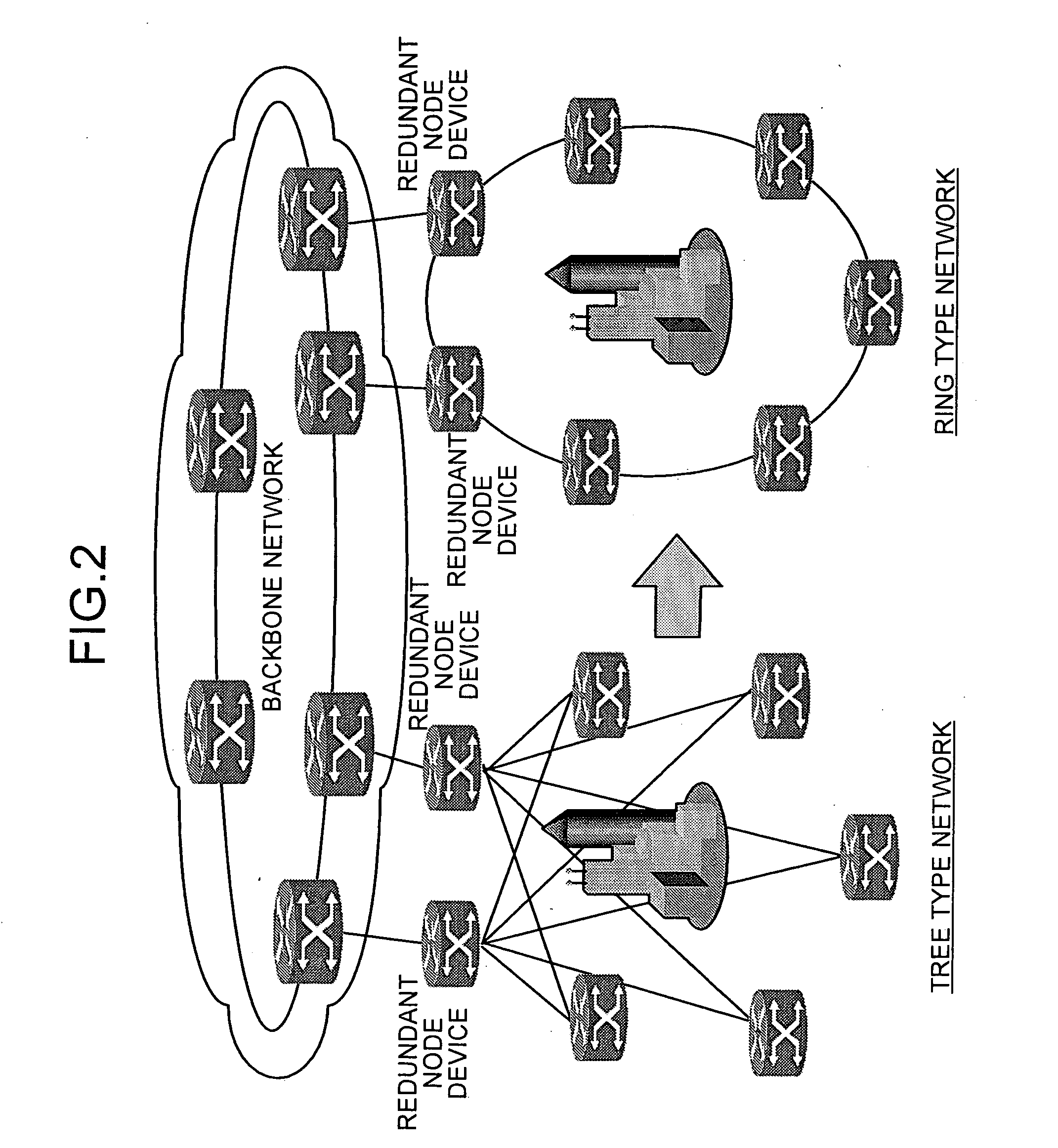Node redundancy method, interface card, interface device, node device, and packet ring network system
a node and network system technology, applied in data switching networks, frequency-division multiplexes, instruments, etc., can solve the problems of telecommunications operators and the like not being able to meet the requirement of high-speed switching with the time of 50 milliseconds or below, and the number of optical fibers being disadvantageously required to be installed anew,
- Summary
- Abstract
- Description
- Claims
- Application Information
AI Technical Summary
Benefits of technology
Problems solved by technology
Method used
Image
Examples
first embodiment
[0066]FIG. 1 is a schematic for explaining the outline of a network according to the present invention. The network includes a RPR network #1 and a RPR network #2 connected to each other with node redundancy.
[0067] The redundant node device also means a redundant node. Moreover, a node device also means a node.
[0068] The RPR network #1 includes a redundant node device #1A, a redundant node device #1B, and node devices #1C to #1F connected to each other in a ring form with an inner loop communication path #1Li and an outer loop communication path #1Lo for bilateral communications. Thus, the RPR network #1 has the dual ring configuration. As a result, even if trouble occurs in one ring, communications can be continued via other ring.
[0069] The RPR network #2 includes a redundant node device #2A, a redundant node device #2B, and node devices #2C to #2F connected to each other in a ring form with an inner loop communication path #2Li and an outer loop communication path #2Lo for bilat...
second embodiment
[0207] In the second embodiment, in addition to (1) priority, (2) common address, and (3) redundant state, (4) redundant group ID is added to a PDU of the keep-alive packet shown in FIG. 7. The redundancy group ID (4) is set to the default state, like other parameters, after power is turned ON, or after resetting.
[0208] As described above, in the second embodiment, by adding a redundancy group ID, a group of redundant node devices in an RPR network is more clarified.
[0209] Although it is possible to differentiate redundancy groups without adding a redundancy group ID to a keep-alive packet because redundancy groups have different common addresses respectively, and in the second embodiment, also a redundancy group ID is added to a keep-alive packet fur the purpose to prepare a ring topology table with higher reliability.
[0210] Further, in the second embodiment, the ring topology table shown in FIG. 17 is used in place of the ring topology table shown in FIG. 9. In the ring topology...
third embodiment
[0220] In the third embodiment, information on a plurality of redundancy groups is set in a PDU in a keep-alive packet shown in FIG. 7.
[0221] In the case of the redundant node device #11D, information on both the redundancy group with the ID set to 1 and the redundancy group with the ID set to 2 is set in a keep-alive packet, and the keep-alive packet is broadcast-delivered to the RPR network #11.
[0222] With this operation, each redundant node device and each node device having received the keep-alive packet prepare a ring topology table shown in FIG. 19.
PUM
 Login to View More
Login to View More Abstract
Description
Claims
Application Information
 Login to View More
Login to View More - R&D
- Intellectual Property
- Life Sciences
- Materials
- Tech Scout
- Unparalleled Data Quality
- Higher Quality Content
- 60% Fewer Hallucinations
Browse by: Latest US Patents, China's latest patents, Technical Efficacy Thesaurus, Application Domain, Technology Topic, Popular Technical Reports.
© 2025 PatSnap. All rights reserved.Legal|Privacy policy|Modern Slavery Act Transparency Statement|Sitemap|About US| Contact US: help@patsnap.com



